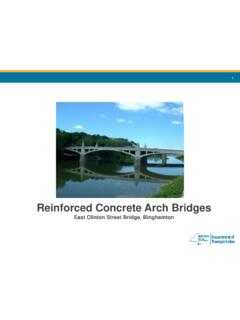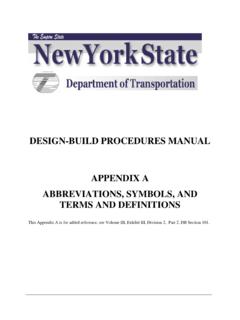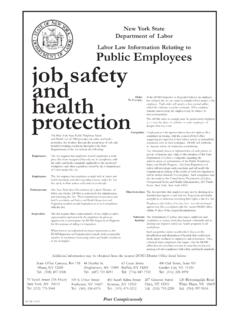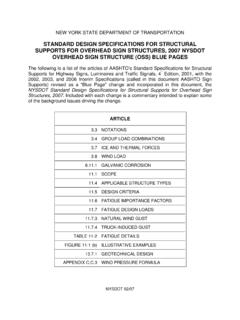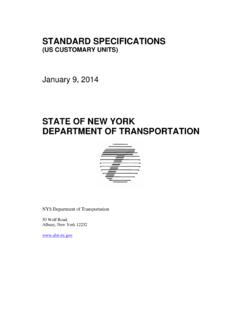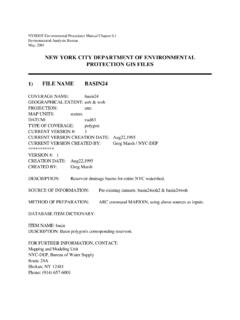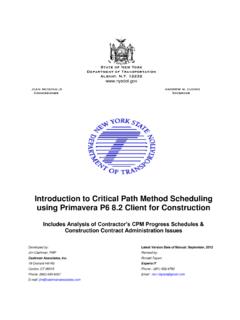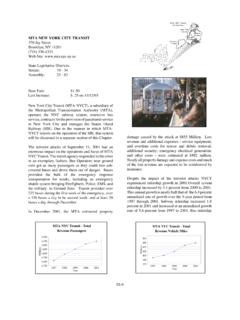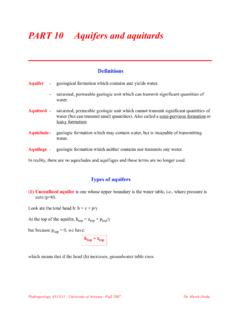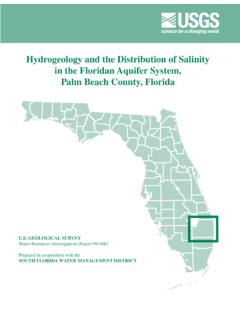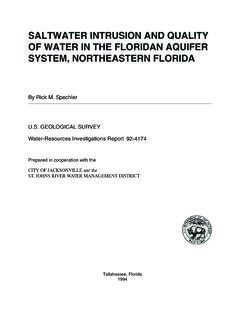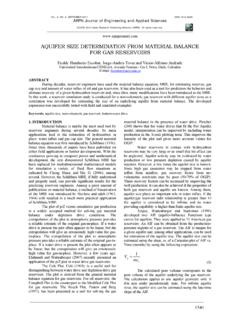Transcription of GROUNDWATER RESOURCES - AQUIFERS
1 CHAPTER GROUNDWATER RESOURCES - AQUIFERS . ENVIRONMENTAL PROCEDURES MANUAL (EPM). April 2008. Third Edition New York State Department of Transportation Environmental Science Bureau NYSDOT. Environmental Procedures Manual, Chapter Page 2 of 22. Environmental Science Bureau. April 2008. AQUIFERS . TABLE OF CONTENTS. Page I. SUMMARY 4. II. DEFINITIONS 8. III. APPLICABILITY 8. IV. PROCEDURES TO COMPLY WITH THE FEDERAL SAFE. DRINKING WATER ACT SOLE SOURCE AQUIFERS .. 9. V. PROCEDURES TO COMPLY WITH NYSDEC PRIMARY. WATER SUPPLY AND PRINCIPAL aquifer AREAS . 12. VI. CITATIONS . 14. VII. ADDITIONAL INFORMATION 15. VIII. FREQUENTLY ASKED QUESTIONS .. 15. ATTACHMENTS. NYS aquifer MAPS AND GIS-DATASETS 16. STATEMENT OF SECTION 1424(e).
2 19. LIST OF PROJECTS THAT TYPICALLY DO NOT. REQUIRE A SECTION 1424(E) REVIEW 20. GROUNDWATER ASSESSMENT REPORTS FOR. EPA-DESIGNATED SOLE SOURCE AQUIFERS . 21. 1984 FHWA AND EPA MOU .. 23. DEC TOGS PRIMARY AND PRINCIPAL. aquifer DETERMINATIONS 26. FINAL UPSTATE NEW YORK GROUNDWATER . MANAGEMENT PLAN PAGES IV-16 THROUGH IV-22 . 34. NYSDOT. Environmental Procedures Manual, Chapter Page 3 of 22. Environmental Science Bureau. April 2008. 40 CFR PART 149 - SOLE SOURCE AQUIFERS , SUBPART B. AND INTERPRETATION CRITERIA FOR EPA STAFF .. 42. Edition Notes: 3rd Edition (April 2008) by Mauricio Roma 2nd Edition (January 2007) by Mauricio Roma 1st Edition (August 1996) by Kyle Williams * Thank you to NYSDOT, NYSDEC and FHWA staff for their contributions NYSDOT.
3 Environmental Procedures Manual, Chapter Page 4 of 22. Environmental Science Bureau. April 2008. I. SUMMARY. Objective, Background, and aquifer Location Objective: Projects must meet existing Federal requirements regarding Sole Source AQUIFERS as well as State requirements regarding Primary- and Principal- AQUIFERS . Background: Highway construction and operation generally contributes to impervious surface area in watersheds. The regular highway use and operations cause an accumulation of pollutants on the surface from oil, tires, dust, grease, road salt, and other materials which may infiltrate the ground or be washed into receiving waters through rain or snow events. Please note that the NYSDOT has an Environmental Handbook for Transportation Operations and other guidance documents to prevent and/or minimize adverse impacts to the environment, whether the transportation corridor is over an aquifer or not.
4 aquifer Location: Figure-1 shows the location of Sole Source- and Primary- AQUIFERS . You can also view and evaluate these AQUIFERS , Principal AQUIFERS , and other GROUNDWATER RESOURCES , in paper maps or in Geographic Information System (GIS) datasets that are available at the NYSDOT ( ). Federally-designated AQUIFERS (Sole Source AQUIFERS ). Section 1424(e) of the Safe Drinking Water Act of 1974 ( ) provides for the United States Environmental Protection Agency (EPA) to designate and protect Sole Source AQUIFERS (Figure-1, and ). A Section 1424(e) review is required for federally funded projects in Sole Source aquifer Areas that have one of the four characteristics listed in Section IV, Step 3, of this EPM. This is because such projects may have the potential to create a significant hazard to public health, defined by EPA as: a) exceeding any National Drinking Water Standards at any point where the water may be used for drinking purposes; or b) otherwise threaten public health.
5 In making this determination, the following factors, at a minimum, are considered by EPA: 1) the toxicity of the contaminants involved;. 2) the volume of contaminants which may enter the aquifer ; and 3) the physical and chemical hydrogeological characteristics of the aquifer and its attenuation capability. These factors should be discussed in a GROUNDWATER Assessment Report. summarizes the requirements for this report. The following web page shows the National Drinking Water Standards: #listmcl NYSDOT must ensure that all federally-aided projects are designed to prevent significant contamination of Sole Source AQUIFERS to a level that may create a significant hazard to public health. To achieve this, some projects may require treatment facilities.
6 Such facilities are NYSDOT. Environmental Procedures Manual, Chapter Page 5 of 22. Environmental Science Bureau. April 2008. described in Chapter 8 of the NYSDOT Highway Design Manual (HDM). The Intradot/Internet links are: IntraDot - publications-and-instructions/highway-de sign-manual/hdm_ch81. Internet - The Federal Highway Administration (FHWA) may not commit Federal financial assistance (through a grant, contract, loan guarantee, or otherwise) for any project which the EPA. Administrator determines may contaminate a Sole Source aquifer so as to create a significant hazard to public health. is the 1984 Memorandum of Understanding (MOU). between FHWA and the EPA. This MOU establishes the types of projects that require Federal review, factors to be considered in the review process, and time frames for review as per Executive Order (EO) 12372.
7 Please refer to the web site: It provides detailed information about New York's Sole Source AQUIFERS , including hydrogeology, susceptibility of contamination, and alternative sources of drinking water. is an example of the process for projects that may be affecting a Sole Source aquifer and the criteria that EPA. personnel use for Highway-related Section 1412 (e) Evaluations. State Identified AQUIFERS (Primary- and Principal- AQUIFERS ). New York State Department of Environmental Conservation (NYSDEC) Technical and Operational Guidance Series (TOGS) ( ) provides guidance to determine whether an aquifer is considered a Primary Water Supply aquifer or a Principal aquifer . is a NYSDEC publication describing and showing the location of Primary-, Principal-, and Sole Source- AQUIFERS as well as other GROUNDWATER RESOURCES .
8 Figures 1 and 2. also show these AQUIFERS . You can also use paper maps or GIS-datasets ( ) to view the AQUIFERS . At present, there are no laws or regulations that directly regulate non-point source impacts from projects in or adjacent to DEC identified Primary- or Principal- AQUIFERS . However, several laws and/or regulations such as State ambient water quality standards & SPDES (Art. 17), Freshwater and Tidal Wetlands (Art. 24 and 25), Wild, Scenic and Recreational Rivers (Art. 15), Stream Protection (Art. 15), Section 401 Water Quality Certification and/or the SEQRA process may apply to NYSDOT projects in or adjacent to designated AQUIFERS . Therefore, NYSDOT should determine if a project is likely to have a potential adverse impact to a state identified aquifer or drinking water sources.
9 The website below shows the State ambient water quality standards: #16130. NOTE: You can find detailed information pertaining to Project Development Process in Chapter 4 of the NYSDOT Project Development Manual (PDM). NYSDOT. Environmental Procedures Manual, Chapter Page 6 of 22. Environmental Science Bureau. April 2008. FIGURE-1: SOLE SOURCE AND PRIMARY AQUIFERS . NYSDOT. Environmental Procedures Manual, Chapter Page 7 of 22. Environmental Science Bureau. April 2008. FIGURE-2: PRIMARY AQUIFERS DOWNSTATE. NYSDOT. Environmental Procedures Manual, Chapter Page 8 of 22. Environmental Science Bureau. April 2008. II. DEFINITIONS. aquifer A geologic unit that is sufficiently permeable to supply adequate quantities of water to wells.
10 Unconsolidated aquifer - An aquifer made of loose materials such as gravel or sand. Valley fill materials are often unconsolidated AQUIFERS . Confined aquifer - An aquifer where water moves beneath a layer of clay or other dense, low- permeability material. Primary aquifer (State) - Highly productive AQUIFERS presently being utilized as sources of water supply by major municipal water supply systems. Generally, primary AQUIFERS are the permeable valley fill materials within a primary aquifer zone, as seen in paper maps or GIS. datasets. Confined AQUIFERS that are predominantly recharged in land areas that are outside the aquifer area are not primary or principal AQUIFERS . Principal aquifer (State) - AQUIFERS known to be highly productive or whose geology suggests an abundant and high quality potential water supply, but which are not intensively used as sources of water supply by major municipal systems at the present time.
